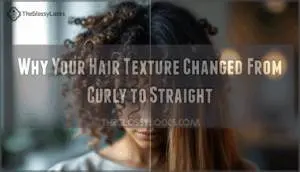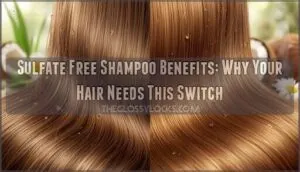This site is supported by our readers. We may earn a commission, at no cost to you, if you purchase through links.

Your follicles respond to a cascade of internal shifts: hormones that reshape the root during puberty or pregnancy, stress that alters growth cycles, or damage from heat tools that permanently disrupts keratin bonds. The shape of each follicle dictates whether your hair emerges straight, wavy, or coiled, and when that geometry changes—through biological signals or external wear—your texture follows.
Understanding what triggers these shifts gives you the power to identify whether your hair is recovering, adapting, or signaling something deeper that needs attention.
Table Of Contents
- Key Takeaways
- Genetics and Hair Texture
- Hormonal Influences
- Hair Replacement and Texture Changes
- Factors Affecting Texture Changes
- Heat Styling and Tight Hairstyles Can Stretch Out Curls
- Product Buildup Can Weigh Down Hair and Cause Frizz
- Hormonal Changes During Puberty and Pregnancy
- Nutritional Deficiencies and Health Issues Can Affect Hair
- Why does only some hair change texture?
- Can medications reverse hair texture from straight back?
- Will cutting hair off restore original curl pattern?
- Conclusion
Key Takeaways
- Your follicle shape—round for straight, oval for curly—is set by genetics, but hormonal surges during puberty or pregnancy can remodel that architecture, permanently flattening curls into waves or straight strands.
- Heat styling and tight hairstyles physically disrupt keratin bonds and stretch follicle openings over time, causing your natural curl pattern to weaken or vanish entirely.
- Product buildup from silicones and waxes adds mechanical weight that pulls curls straighter while blocking moisture, reducing bounce by up to 30% and dulling your hair’s natural texture.
- Nutritional deficiencies—especially iron, protein, and biotin—strip follicles of the building blocks needed for keratin synthesis, weakening curl patterns within months but often reversing with proper supplementation in 3–6 months.
Genetics and Hair Texture
Your hair’s curl pattern comes down to one thing: the shape of your hair follicles. It’s all determined by genetics, and it’s where the story starts.
Understanding how your follicles work is key to figuring out why your texture might’ve changed.
Shape of Follicle Determines Curl Shape
Your follicle shape is the blueprint for your curl pattern. Round follicles produce straight hair, while oval or flattened follicles create curly hair.
This follicle geometry determines fiber structure through asymmetric cellular activity during growth. The more elliptical your hair follicles, the tighter your curl patterns become. These asymmetry effects stem from uneven tension across the developing hair shaft, establishing your natural hair morphology at the root level before strands even emerge from your scalp.
Understanding the role of hair follicle anatomy is essential in determining curl patterns.
Oval Follicles Lead to Curly Hair
When follicle asymmetry increases, your curl tightness follows. Oval follicles generate curly hair through uneven keratin distribution across the developing shaft. This biomechanics creates measurable effects:
- Elliptical cross-sections measure 0.5–0.7 circularity compared to 0.9 in straight hair
- Flatter ovals produce tighter curls through greater asymmetric tension
- Genetic variants in TCHH and KRT74 genes influence follicle geometry
- Cortical cells align asymmetrically, establishing directional bending forces
- Hair emerges at 20°–40° angles from the scalp, amplifying natural curl
Your hair follicle shape and texture connection is largely genetic—twin studies show 85–90% heritability. However, hair texture changes can occur when aging, hormonal shifts, or damage alter follicle geometry over time. Understanding the curly hair gene is essential for determining individual hair texture.
Hormonal Influences
Your body’s hormones don’t just control mood—they reshape your hair from the inside out. During puberty and pregnancy, these chemical shifts can flip your follicle’s blueprint entirely.
Here’s how these changes work their way from your bloodstream to your strands.
Hormone Fluctuations During Puberty and Pregnancy
Your body undergoes profound hormonal shifts during puberty and pregnancy that can reshape your hair from the root up. These hormone fluctuations affect follicle structure and growth cycles, sometimes transforming curls into straighter strands.
Puberty effects include rising androgen levels that enlarge oil glands and alter follicle shape, while pregnancy changes—driven by elevated estrogen and progesterone—prolong growth phases and increase hair diameter. The estrogen impact keeps more strands actively growing, creating a thicker texture temporarily. After delivery, hormonal influences on hair reverse sharply, triggering shedding and follicle alterations that may straighten previously curly patterns.
Understanding these natural hormonal changes helps you adapt your care routine thoughtfully.
| Life Stage | Primary Hormones | Common Texture Effect |
|---|---|---|
| Puberty | Androgens (testosterone, DHT) | Coarser, oilier, sometimes straighter strands |
| Pregnancy | Estrogen, progesterone | Thicker, fuller hair with enhanced curl or wave |
| Postpartum | Declining estrogen, elevated cortisol | Temporary shedding, potential curl loosening |
Hypothesized to Cause Texture Changes
Though hormonal shifts aren’t yet fully understood, researchers suspect they trigger follicular remodeling that straightens curls. Genetic variants influence how sensitive your follicles are to these fluctuations, while aging gradually reduces follicle curvature. Environmental factors and chemical damage compound these hair texture changes.
You’ll notice hormonal changes during puberty, pregnancy, and menopause often coincide with permanent shifts—suggesting hormones reshape follicle structure itself, not just growth patterns. Genetics sets your baseline response to these internal signals.
Hair Replacement and Texture Changes
Your hair doesn’t just sit on your head forever—it’s constantly being replaced. Each time a new strand grows in, the follicle that produces it can shift shape, and that shift can change your texture.
Here’s how this natural cycle can turn curls into straight strands over time.
Continuous Hair Replacement Process
Your scalp operates like a factory floor running 24/7—roughly 100,000 hair follicles cycling independently through growth, rest, and shedding phases. Each follicle cycles ten to thirty times in your lifetime, with about 85% actively growing at any moment.
This continuous hair replacement process means you’re shedding 50-150 hairs daily while new ones emerge from stem cells activated by dermal papilla signals.
When follicle shape shifts due to hormones, stress, or aging, your anagen duration shortens and the newly formed hair shaft reflects that altered architecture—transforming curls into straighter strands without you consciously changing a thing.
Different Follicle Shape Can Change Hair Texture
Follicle architecture is the blueprint behind your hair’s personality—and when that structure shifts, your curls can vanish. The shape determines curl pattern through three key mechanisms: follicle asymmetry creates the curvature you see, uneven keratin distribution along the follicle wall builds tension that bends strands, and growth factors like IGFBP-5 regulate how tightly hair coils as it emerges.
Here’s what drives those shifts:
- Hormonal surges during puberty or pregnancy remodel dermal papilla signaling, altering the angle and curvature of new growth.
- Chronic heat styling or product buildup physically deforms follicle openings, gradually straightening your curl pattern.
- Nutritional gaps in zinc or biotin weaken keratin bonds, disrupting the matrix stiffness that maintains follicle shape.
When your follicles change—whether from age, stress, or external damage—your hair texture changes with them, transforming curls into waves or straight strands without warning.
Factors Affecting Texture Changes
Your hair’s shift from curly to straight isn’t random—it’s the result of specific biological and environmental forces working on your follicles. Some of these factors are within your control, while others reflect natural processes your body undergoes over time.
Here’s what’s actually changing your curl pattern.
Heat Styling and Tight Hairstyles Can Stretch Out Curls
Heat styling tools can permanently alter your hair texture by disrupting keratin bonds and damaging the cuticle. This heat damage weakens curls, making them limp or straight over time.
Tight hairstyles create constant tension that causes hair breakage and can lead to tension alopecia, especially along your hairline.
Your best defense? Embrace protective styling, use heat protectants religiously, and practice style moderation. Give your hair regular breaks to support curl recovery and maintain its natural texture.
Product Buildup Can Weigh Down Hair and Cause Frizz
Product buildup acts like an invisible weight pressing down on your curls, literally flattening them into submission. When silicone-based and wax-heavy products accumulate on your hair shaft, they create a coating that stretches out your natural curl pattern and blocks moisture from getting through.
Here’s what buildup does to your texture:
- Weighs down curls: Residue adds mechanical weight that can reduce bounce by up to 30%, physically pulling curls straighter.
- Creates surface friction: Silicone and wax deposits stiffen strands and interfere with the natural swelling patterns that give curls their spring.
- Triggers scalp issues: Buildup combines with sebum to form a waxy layer that clogs follicles and throws off your scalp’s pH balance.
Your hair loses its light-reflecting quality, appearing dull even right after washing. Regular clarifying shampoos every 2–4 weeks restore curl definition by stripping away accumulated residues.
Hormonal Changes During Puberty and Pregnancy
Your body rewrites the rules during puberty and pregnancy—hormone surges don’t just shift your mood, they reshape your follicles. Puberty hair changes happen when rising estrogen increases follicular diameter, potentially transforming straight strands into waves or curls.
During pregnancy, hair texture shifts as estrogen levels rise up to 10-fold, keeping 85–90% of follicles actively growing and boosting density. Postpartum hair loss strikes when estrogen plummets by 90%, triggering shedding in up to 50% of new mothers within 3–6 months—often accompanied by dryness or frizz as hormonal follicle modulation disrupts your scalp’s natural oil production.
Nutritional Deficiencies and Health Issues Can Affect Hair
What you eat—or lack—can rewrite your hair story. Nutritional deficiencies strip follicles of the building blocks they need, weakening curl patterns and leaving strands thin, brittle, or straight. Iron deficiency affects up to 59% of women with hair loss, while low protein disrupts keratin synthesis within months. Restoring these nutrients often reverses texture changes within 3–6 months.
- Protein deficiency weakens disulfide bonds in keratin, flattening curls and thinning strands
- Iron deficiency (ferritin Your hair’s identity hinges on follicle shape—when it shifts from hormones, aging, or genetics, your texture follows
Round follicles pump out straight strands, while oval ones create curls. A texture shift happens when follicle health changes, altering the hair structure emerging from your scalp.
Why does only some hair change texture?
Your body doesn’t apply hormonal changes or environmental stress evenly across your scalp. Localized factors like scalp variation and uneven impact create patchwork changes.
Follicle sensitivity differs by region, so hormonal fluctuations affect some hair follicles more than others, causing only certain sections to shift texture.
Can medications reverse hair texture from straight back?
Medication can’t directly reverse your hair texture from straight back to curly. However, addressing underlying hormonal imbalances or nutritional deficiencies through treatment may support healthier follicle function, which could influence texture over time as new hair grows.
Will cutting hair off restore original curl pattern?
Cutting off damaged hair removes split ends and buildup, but it won’t restore your original curl pattern if your hair follicles have changed shape.
Regrowth texture depends on follicle memory, not length. However, removing hair damage can reveal healthier curls.
Conclusion
Your follicles won’t announce their next move, but the clues are already present—shifts in hormones, stress patterns, or accumulated damage quietly rewriting your curl blueprint. Understanding why hair texture changed from curly to straight means recognizing these biological signals before they become permanent.
Some changes reverse with better nutrition or gentler styling; others mark a natural evolution your genetics already scripted. The real power isn’t forcing your hair back into old patterns—it’s learning to read what your strands are telling you and responding with precision, not panic.
- https://www.23andme.com/topics/traits/hair-texture/
- https://www.healthline.com/health/is-curly-hair-dominant-or-recessive
- https://pmc.ncbi.nlm.nih.gov/articles/PMC7432488/
- https://theconversation.com/from-straight-to-curly-thick-to-thin-heres-how-hormones-and-chemotherapy-can-change-your-hair-219329
- https://medlineplus.gov/ency/article/004005.htm








